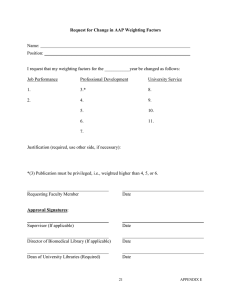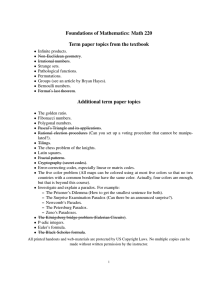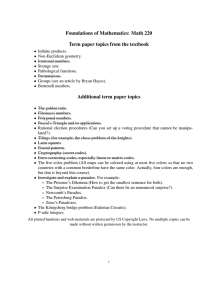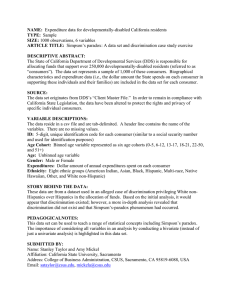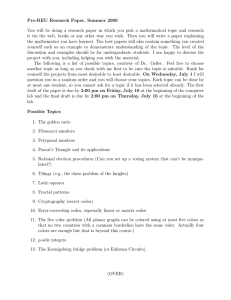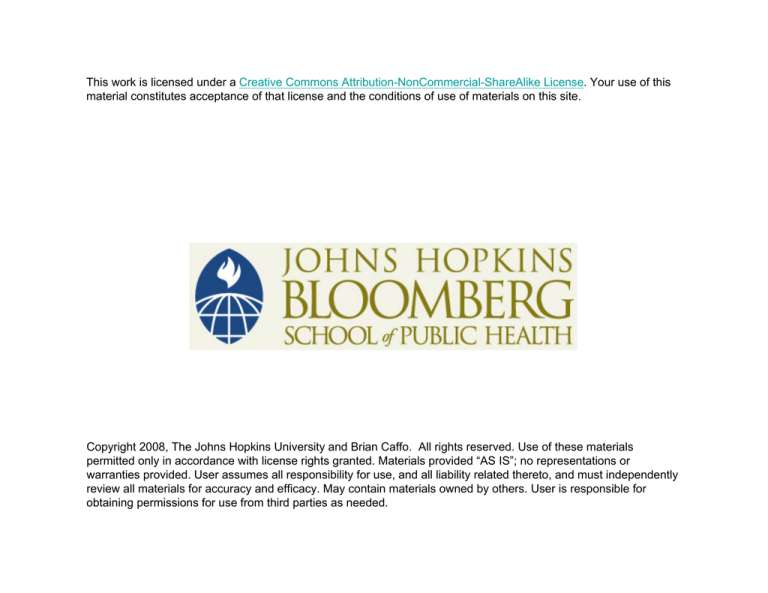
This work is licensed under a Creative Commons Attribution-NonCommercial-ShareAlike License. Your use of this
material constitutes acceptance of that license and the conditions of use of materials on this site.
Copyright 2008, The Johns Hopkins University and Brian Caffo. All rights reserved. Use of these materials
permitted only in accordance with license rights granted. Materials provided “AS IS”; no representations or
warranties provided. User assumes all responsibility for use, and all liability related thereto, and must independently
review all materials for accuracy and efficacy. May contain materials owned by others. User is responsible for
obtaining permissions for use from third parties as needed.
Lecture 23
Brian Caffo
Table of
contents
Outline
Simpson’s
paradox
Lecture 23
Berkeley data
Confounding
Weighting
Mantel/Haenszel
estimator
Brian Caffo
Department of Biostatistics
Johns Hopkins Bloomberg School of Public Health
Johns Hopkins University
November 15, 2007
Lecture 23
Table of contents
Brian Caffo
Table of
contents
Outline
1 Table of contents
Simpson’s
paradox
Berkeley data
2 Outline
Confounding
Weighting
Mantel/Haenszel
estimator
3 Simpson’s paradox
4 Berkeley data
5 Confounding
6 Weighting
7 Mantel/Haenszel estimator
Lecture 23
Brian Caffo
Table of
contents
Outline
Simpson’s
paradox
Berkeley data
1
Simpson’s paradox
Confounding
2
Weighting
3
CMH estimate
4
CMH test
Weighting
Mantel/Haenszel
estimator
Lecture 23
Simpson’s (perceived) paradox
Brian Caffo
Table of
contents
Outline
Simpson’s
paradox
Victim
White
Berkeley data
Confounding
Weighting
Black
Mantel/Haenszel
estimator
White
Black
Defendant
White
Black
White
Black
White
Black
Death penalty
yes
no
53
414
11
37
0
16
4
139
53
430
15
176
64
451
4
155
% yes
11.3
22.9
0.0
2.8
11.0
7.9
12.4
2.5
1
1
From Agresti, Categorical Data Analysis, second edition
Lecture 23
Brian Caffo
Discussion
Table of
contents
Outline
Simpson’s
paradox
Berkeley data
Confounding
Weighting
Mantel/Haenszel
estimator
• Marginally, white defendants received the death penalty a
greater percentage of time than black defendants
• Across white and black victims, black defendant’s received
the death penalty a greater percentage of time than white
defendants
• Simpson’s paradox refers to the fact that marginal and
conditional associations can be opposing
• The death penalty was enacted more often for the murder
of a white victim than a black victim. Whites tend to kill
whites, hence the larger marginal association.
Lecture 23
Example
Brian Caffo
Table of
contents
Outline
Simpson’s
paradox
Berkeley data
• Wikipedia’s entry on Simpson’s paradox gives an example
comparing two player’s batting averages
Confounding
Weighting
Mantel/Haenszel
estimator
Player 1
Plater 2
First
Half
4/10 (.40)
35/100 (.35)
Second
Half
25/100 (.25)
2/10 (.20)
Whole
Season
29/110 (.26)
37/110 (.34)
• Player 1 has a better batting average than Player 2 in
both the first and second half of the season, yet has a
worse batting average overall
• Consider the number of at-bats
Lecture 23
Brian Caffo
Berkeley admissions data
Table of
contents
Outline
Simpson’s
paradox
• The Berkeley admissions data is a well known data set
Berkeley data
regarding Simpsons paradox
Confounding
?UCBAdmissions
data(UCBAdmissions)
apply(UCBAdmissions, c(1, 2), sum)
Gender
Admit
Male Female
Admitted 1198
557
Rejected 1493
1278
.445
.304 <- Acceptance rate
Weighting
Mantel/Haenszel
estimator
Lecture 23
Brian Caffo
Table of
contents
Outline
Simpson’s
paradox
Berkeley data
Confounding
Weighting
Mantel/Haenszel
estimator
Acceptance rate by department
> apply(UCBAdmissions, 3,
function(x) c(x[1] / sum(x[1 : 2]),
x[3] / sum(x[3 : 4])
)
)
Dept M
F
A 0.62 0.82
B 0.63 0.68
C 0.37 0.34
D 0.33 0.35
E 0.28 0.24
F 0.06 0.07
Lecture 23
Brian Caffo
Table of
contents
Outline
Simpson’s
paradox
Berkeley data
Confounding
Weighting
Mantel/Haenszel
estimator
Why? The application rates by department
> apply(UCBAdmissions, c(2, 3), sum)
Dept
Gender
A
B
C
D
E
F
Male
825 560 325 417 191 373
Female 108 25 593 375 393 341
Lecture 23
Discussion
Brian Caffo
Table of
contents
Outline
Simpson’s
paradox
Berkeley data
Confounding
Weighting
Mantel/Haenszel
estimator
• Mathematically, Simpson’s pardox is not paradoxical
a/b < c/d
e/f
< g /h
(a + e)/(b + f ) > (c + g )/(d + h)
• More statistically, it says that the apparent relationship
between two variables can change in the light or absence
of a third
Lecture 23
Confounding
Brian Caffo
Table of
contents
Outline
Simpson’s
paradox
Berkeley data
Confounding
Weighting
Mantel/Haenszel
estimator
• Variables that are correlated with both the explanatory
and response variables can distort the estimated effect
• Victim’s race was correlated with defendant’s race and
death penalty
• One strategy to adjust for confounding variables is to
stratify by the confounder and then combine the
strata-specific estimates
• Requires appropriately weighting the strata-specific
estimates
• Unnecessary stratification reduces precision
Lecture 23
Aside: weighting
Brian Caffo
Table of
contents
Outline
Simpson’s
paradox
Berkeley data
Confounding
Weighting
Mantel/Haenszel
estimator
• Suppose that you have two unbiased scales, one with
variance 1 lb and and one with variance 9 lbs
• Confronted with weights from both scales, would you give
both measurements equal creedance?
• Suppose that X1 ∼ N(µ, σ12 ) and X2 ∼ N(µ, σ22 ) where σ1
and σ2 are both known
• log-likelihood for µ
−(x1 − µ)2 /2σ12 − (x2 − µ)2 /2σ22
Lecture 23
Continued
Brian Caffo
Table of
contents
Outline
• Derivative wrt µ set equal to 0
Simpson’s
paradox
(x1 − µ)/σ12 + (x2 − µ)/σ22 = 0
Berkeley data
Confounding
• Answer
Weighting
Mantel/Haenszel
estimator
x1 r1 + x2 r2
= x1 p + x2 (1 − p)
r1 + r2
where ri = 1/σi2 and p = r1 /(r1 + r2 )
• Note, if X1 has very low variance, its term dominates the
estimate of µ
• General principle: instead of averaging over several
unbiased estimates, take an average weighted according to
inverse variances
• For our example σ12 = 1, σ22 = 9 so p = .9
Lecture 23
Mantel/Haenszel estimator
Brian Caffo
Table of
contents
Outline
Simpson’s
paradox
Berkeley data
Confounding
Weighting
Mantel/Haenszel
estimator
• Let nijk be entry i, j of table k
• The k th sample odds ratio is θ̂k = nn11k nn22k
12k 21k
P
r θ̂
• The Mantel Haenszel estimator is of the form θ̂ = Pk kr k
k k
n21k
• The weights are rk = n12k
n
++k
P
n n /n
• The estimator simplifies to θ̂MH = Pk n11k n22k /n++k
++k
k 12k 21k
• SE of the log is given in Agresti (page 235) or Rosner
(page 656)
Lecture 23
Brian Caffo
Table of
contents
Outline
Simpson’s
paradox
Berkeley data
Confounding
1
S F
T 11 25
C 10 27
n
73
2
S F
16 4
22 10
52
3
S F
14 5
7 12
38
Center
4
5
S F
S F
2 14
6 11
1 16
0 12
33
29
6
S F
1 10
0 10
21
7
S
1
1
F
4
8
14
8
S
4
6
F
2
1
13
Weighting
Mantel/Haenszel
estimator
S - Success, F - failure
T - Active Drug, C - placebo2
θ̂MH =
(11 × 27)/73 + (16 × 10)/25 + . . . + (4 × 1)/13
= 2.13
(10 × 25)/73 + (4 × 22)/25 + . . . + (6 × 2)/13)
ˆ
Also log θ̂MH = .758 and SE
log θ̂MH = .303
2
Data from Agresti, Categorical Data Analysis, second edition
Lecture 23
CMH test
Brian Caffo
Table of
contents
Outline
Simpson’s
paradox
Berkeley data
• H0 : θ1 = . . . = θk = 1 versus Ha : θ1 = . . . = θk 6= 1
Confounding
• The CHM test applies to other alternatives, but is most
Weighting
Mantel/Haenszel
estimator
powerful for the Ha given above
• Same as testing conditional independence of the response
and exposure given the stratifying variable
• CMH conditioned on the rows and columns for each of the
k contingency tables resulting in k hypergeometric
distributions and leaving only the n11k cells free
Lecture 23
CMH test cont’d
Brian Caffo
Table of
contents
Outline
Simpson’s
paradox
Berkeley data
Confounding
Weighting
Mantel/Haenszel
estimator
• Under the conditioning and under the null hypothesis
• E (n11k ) = n1+k n+1k /n++k
2
• Var(n11k ) = n1+k n2+k n+1k n+2k /n++k
(n++k − 1)
• The CMH test statistic is
[
P
− E (n11k )}]2
k Var(n11k )
k {n
P11k
• For large sample sizes and under H0 , this test statistic is
χ2 (1) (regardless of how many tables you are summing up)
Lecture 23
Brian Caffo
In R
Table of
contents
Outline
Simpson’s
paradox
Berkeley data
Confounding
Weighting
Mantel/Haenszel
estimator
dat <- array(c(11, 10, 25, 27, 16, 22, 4, 10,
14, 7, 5, 12,
2, 1, 14, 16,
6, 0, 11, 12,
1, 0, 10, 10,
1, 1, 4, 8,
4, 6, 2, 1),
c(2, 2, 8))
mantelhaen.test(dat, correct = FALSE)
Results: CMHTS = 6.38
P-value: .012
Test presents evidence to suggest that the treatment and
response are not conditionally independent given center
Lecture 23
Some final notes on CMH
Brian Caffo
Table of
contents
Outline
Simpson’s
paradox
Berkeley data
Confounding
Weighting
Mantel/Haenszel
estimator
• It’s possible to perform an analogous test in a random
effects logit model that benefits from a complete model
specification
• It’s also possible to test heterogeneity of the strata-specific
odds ratios
• Exact tests (guarantee the type I error rate) are also
possible exact = TRUE in R

